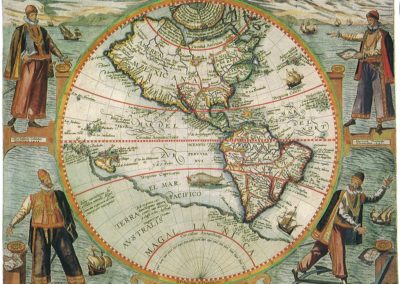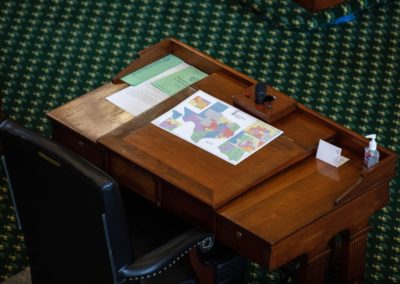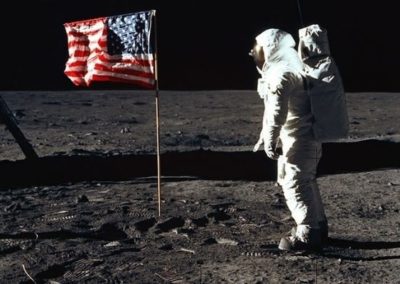Of Eras and Ages: Understanding Earth’s Geologic Time Scale
There’s a lot more to history than what people have written down!
By: James Fite | August 13, 2025 | 835 Words

(Photo by Lyvans Boolaky/Getty Images)
Do you know what began in the Archean eon? How about what kind of critters were alive during the Mesozoic era, the Cretaceous period, or the Eocene epoch? For that matter, what are an eon, era, period, or epoch? Hang around, and you’ll find the answers to all this and more. Join Liberty Nation GenZ on a journey through time to explore Earth’s natural history, starting with the Geologic Time Scale.
The Geologic Time Scale
Most people tend to think of history as the story of humanity through time. To some degree, that’s right. Human history is the tale of kingdoms and empires, of wars and plagues, and of advancements in art and science. But that’s not the whole story. Humanity as we know it has existed, scientists believe, for only about 0.004% of Earth’s history. To put that in a way that’s easier to understand, people are, as one PBS narrator put it, the last word on the last page of Earth’s history so far.
 So how do we peer deeper into our home planet’s past than that recounted in the histories, legends, and myths of humanity? That’s where the Geologic Time Scale comes into play. Geologists – people who study the structure, composition, and history of Earth – devised this system to separate the 4.5 billion years of our world’s existence into manageable categories. And they do this by studying rocks and fossils.
So how do we peer deeper into our home planet’s past than that recounted in the histories, legends, and myths of humanity? That’s where the Geologic Time Scale comes into play. Geologists – people who study the structure, composition, and history of Earth – devised this system to separate the 4.5 billion years of our world’s existence into manageable categories. And they do this by studying rocks and fossils.
There are five levels of division based on what scientists have found in the layers of rocks, sediment, and fossils in Earth’s crust. The broadest segments are called eons, and they can stretch from hundreds of millions of years to billions of years. Each eon is then made up of multiple eras, which separate into periods, then epochs, and finally ages. These aren’t always equal in length or evenly distributed. That’s because they aren’t determined by set spans of time but by major historical events that changed the face of Earth itself or by cataclysmic extinction events and explosions of new life.
From Eons to Ages
At its broadest level, the Geologic Time Scale separates Earth’s history into four eons. From oldest to youngest, they’re the Hadean, the Archean, the Proterozoic, and the Phanerozoic – the last of which we’re in right now.
Recall the opening question about the Archean eon? Well, here it is: The Archean eon, which ran from about 4 billion years ago to about 2.5 billion years ago, marked the change of Earth from a molten, inhospitable planet to one with land, water, and even the first signs of life in the first single-celled organisms.
The next largest category in the Geologic Time Scale is the era. The Hadean eon isn’t subdivided further. But the other three are separated into ten total eras. The Archean eon is made up of the Eoarchean, Paleoarchean, Mesoarchean, and Neoarchean eras. The Proterozoic eon includes the Paleoproterozoic, Mesoproterozoic, and Neoproterozoic eras.
 The current Phanerozoic eon, which began about 541 million years ago, includes the Paleozoic, Mesozoic, and Cenozoic eras. From the beginnings of fish, mollusks, insects, amphibians, and reptiles of the Paleozoic to the Mesozoic’s dinosaurs and all of human history in the current Cenozoic era, it accounts for most of the forms of life we think about today. The very name of the eon means “visible life,” and each era within showcases the journey of life through to the modern age.
The current Phanerozoic eon, which began about 541 million years ago, includes the Paleozoic, Mesozoic, and Cenozoic eras. From the beginnings of fish, mollusks, insects, amphibians, and reptiles of the Paleozoic to the Mesozoic’s dinosaurs and all of human history in the current Cenozoic era, it accounts for most of the forms of life we think about today. The very name of the eon means “visible life,” and each era within showcases the journey of life through to the modern age.
Eras are further divided into periods, of which there are 22. Those are broken down into 37 epochs, which are then split into a whopping 96 ages. Right now, we’re in the Meghalayan age of the Holocene epoch of the Quaternary period of the Cenozoic era of the Phanerozoic eon. That’s a mouthful!
So, another question. What critters were around during certain time periods? Well, as we already said, the Mesozoic era saw dinosaurs. The Cretaceous was one period in this era, which saw the dominance of non-avian dinosaurs. The Eocene epoch, however, belonged to the Paleogene period of the Cenozoic era – and that’s where we saw the rise of mammals and the breakup of the supercontinents Laurasia and Gondwana.
Seems like a lot, doesn’t it? This journey through time is only just beginning. Think of this as an orientation to set the scene – a broad overview and introduction to what you’ll see along the way. And don’t worry, from here on out, we’ll deal with just one topic at a time, keeping it simple and manageable from the very first eon to the final age.

- Humanity as we know it has existed, scientists believe, for only about 0.004% of Earth’s history.
- Geologists devised the Geologic Time Scale to separate the 4.5 billion years of the world’s existence into manageable categories.
- The five levels of division are based on what scientists have found in the layers of rocks, sediment, and fossils in the Earth’s crust.
















